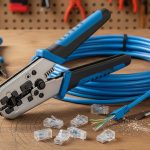
In today’s digital world, a power outage isn’t just an inconvenience—it’s a threat to connectivity, data integrity, and even essential medical care. The modern home, RV, and job site rely on a vast array of sensitive electronics, including laptops, flat-screen TVs, medical devices, and sophisticated charging systems. Plugging these valuable items into a generator used to be a gamble, resulting in the dreaded ‘fried circuit board’ scenario.
Fortunately, the advent of inverter generators has fundamentally changed the landscape of portable power. This comprehensive, 2000+ word guide will delve into the technical reasons why Inverter Generators For Sensitive Electronics are not just a good choice, but a necessary one, exploring how their unique technology provides the clean, stable power that modern equipment demands.
The Problem with Dirty Power and Conventional Generators
To appreciate the superiority of inverter technology, we must first understand the limitations and dangers posed by traditional, or “conventional,” generators.
Defining Power Quality—The Sine Wave
Utility power delivered to your home is defined by two main characteristics: voltage (how hard the electricity pushes) and frequency (how often the direction of flow changes). In North America, this is typically 120 volts at 60 Hertz (Hz), delivered in a smooth, continuous, oscillating pattern known as a pure sine wave. This wave is crucial because it ensures the power is delivered efficiently and predictably.
The Chaos of the Conventional Generator
A conventional generator produces power by tying the engine’s RPM (revolutions per minute) directly to the power output. To maintain the required 60 Hz frequency, the engine must constantly run at a fixed, high speed—typically 3,600 RPM—regardless of how many appliances are plugged in. Consequently, when the load suddenly changes (e.g., a refrigerator compressor kicks on or off), the engine briefly struggles, causing the voltage and frequency to spike or dip dramatically. This instability leads to:
- Total Harmonic Distortion (THD): The waveform becomes jagged, distorted, and irregular—often referred to as dirty power. Conventional generators can produce power with a THD of 15% to 25% or higher.
- Voltage Spikes: These erratic surges can instantly damage the delicate microprocessors and circuits found in modern sensitive electronics, effectively “frying” the circuit board.
To fully grasp the magnitude of dirty power from a conventional generator, consider the physical forces at play. A conventional generator’s alternator is directly connected to the engine, meaning its speed is the master of frequency. Inevitably, when an appliance with a large motor (like a sump pump) is manually plugged into a conventional generator, the initial current draw (inrush current) creates a momentary but severe drag on the engine. This instantaneous drag causes the RPM to drop, which in turn causes the frequency (Hz) to momentarily plummet before the mechanical governor can react and speed the engine back up. These rapid, uncontrolled changes in frequency and voltage wreak havoc on appliance motors and digital components.
In appliance motors, these fluctuations generate excess heat and torque, accelerating wear on windings and bearings. Furthermore, for a modern router or television, these voltage and frequency swings are interpreted as electrical noise, forcing the internal power supply to constantly adjust, which burns energy as heat and reduces the lifespan of the device’s internal components. This continuous electrical stress is entirely avoided with an inverter generator, which uses its electronic buffer—the DC stage—to absorb these sudden changes and output a smooth, clean wave, regardless of the engine’s momentary struggle. Therefore, the conventional unit not only risks immediate damage to your sensitive electronics but also reduces the long-term lifespan of all connected appliances due to chronic electrical stress.
For more detail on these limitations, a side-by-side comparison of different generator types is informative: inverter generators vs conventional generators.
The Inverter Solution—How Technology Cleans the Power
Inverter technology decouples the engine speed from the power frequency, providing a fundamentally different and superior approach to generating electricity.
The Three-Phase Conversion Process
The secret to an inverter generator’s clean power lies in its unique, three-stage process, which converts the rough AC power produced by the alternator into stable AC power:
- High-Frequency AC Generation: The engine spins a small, multi-pole alternator to produce high-frequency, raw alternating current (AC).
- Rectification (AC to DC): This AC power is immediately passed through a rectifier, converting it into direct current (DC) power. This DC stage acts as a crucial conditioning buffer, removing the vast majority of the “dirty” spikes and fluctuations.
- Inversion (DC back to AC): The clean DC power is then fed into the inverter stage (a sophisticated set of electronic components) which “inverts” the DC back into AC power. This inversion process synthesizes a perfectly regulated, near-perfect pure sine wave at the required 120V and 60 Hz.
This process ensures the THD is kept incredibly low—typically 3% or less, often matching or exceeding the quality of standard utility power. This “clean power” is what makes Inverter Generators For Sensitive Electronics the standard choice.
If you’re interested in the mechanics, an excellent resource for deeper technical understanding is available here: how does inverter generator work.
Total Harmonic Distortion (THD)—The Key Metric
The THD rating is the single most important specification when powering digital equipment. Modern electronics, such as computers and programmable logic controllers (PLCs), rely on precise timing and current flow. A high THD can lead to system crashes, premature component failure, and calibration errors. Specifically, a THD above 5% can be problematic for medical equipment like oxygen concentrators or diagnostic tools. The low THD provided by the pure sine wave of an inverter generator is essential for maintaining the integrity and function of these crucial devices.
The importance of low Total Harmonic Distortion (THD) goes beyond simple functionality; it touches on the efficiency and even the integrity of data. When the waveform is distorted (high THD), the current contains non-fundamental frequencies (harmonics) that are essentially useless energy. These harmonics travel through the wires, creating unnecessary heat, which is a major enemy of all electronics. Specifically, power supplies in computers and monitors are designed with filters to handle minimal THD. When exposed to 15% to 25% THD from a conventional unit, these internal filters become overwhelmed, allowing the distorted current to reach the sensitive motherboard and memory chips.
Moreover, low THD is directly related to a good Power Factor (PF). A high PF means the power the generator is producing is being used efficiently by the load. Conversely, high THD leads to a poor PF, meaning the generator must work harder to supply the same amount of useful power, burning more fuel. Thus, the electronic conditioning of the inverter generator—producing a THD of 3% or less—is a comprehensive solution: it protects your valuable sensitive electronics, reduces operational noise, and enhances fuel efficiency simultaneously.
Primary Advantages of Inverter Generators for Digital Life
Beyond the technical purity of the power, the design of inverter generators offers several practical benefits that safeguard and enhance the use of sensitive electronics.
Eco-Throttle (Variable Engine Speed)
Because the inverter handles the frequency regulation, the engine only needs to run fast enough to meet the current power demand. This is often called the Eco-Throttle or Smart Throttle feature. Consequently, when you are only charging a phone or running a few lights, the engine slows down, reducing the RPM. This variable speed operation provides three major advantages for electronics:
- Noise Reduction: Quieter operation, making them ideal for camping, RVs, and residential areas where constant loud noise would be disruptive.
- Fuel Efficiency: Significantly lower fuel consumption (sometimes 20-40% less than a conventional generator at the same load), extending run time and lowering operational costs.
- Engine Longevity: Less wear and tear on the engine due to not constantly running at maximum RPM.
Parallel Capability
A unique feature of many inverter generators is the ability to parallel two smaller units together using a simple cable. This allows the user to double their power output (wattage) without sacrificing power quality or having to purchase and maneuver one very large, heavy generator. Therefore, you can use a single, small inverter for charging sensitive equipment most of the time, and then quickly link a second unit when a high-draw appliance (like a small air conditioner) is needed, maintaining the same low THD throughout.
This capability is particularly beneficial for RV owners. If you are preparing for a life on the road, you may want to look into the best inverter generators for RV use.
Sizing and Selecting the Right Inverter Generator
Choosing the right unit involves more than just looking at the price tag. You must accurately match the generator’s capacity to the needs of your sensitive electronics and other appliances.
The Starting Watts vs. Running Watts Balance
When calculating your needs, remember that motorized appliances (refrigerators, pumps, air conditioners) require a brief, high surge of power known as starting watts. Digital and sensitive electronics, however, primarily care about running watts (the continuous power draw) and, more importantly, the THD. To ensure proper operation and protection for your digital devices, your inverter must be sized to handle the *running watts* of your largest motorized appliance plus the running watts of all simultaneously connected electronics.
A simple rule of thumb for sensitive electronics is to always ensure the generator’s capacity exceeds the total load by at least 20% to account for any unforeseen minor fluctuations without tripping the circuit.
Connectivity Features and Data Protection
Many modern inverter generators include advanced connectivity features that are beneficial when powering electronics. Look for:
- Dedicated USB Ports: For direct charging of phones and tablets without needing separate wall adapters.
- App Control: Allows you to monitor fuel level, run time, and power output remotely via a smartphone, ensuring you don’t run out of fuel mid-upload or mid-teleconference.
- Circuit Breakers/Overload Protection: A mandatory safety feature that automatically shuts down the unit if a catastrophic overload occurs, protecting both the generator and the connected electronics.
Specific Applications for Sensitive Power
The need for clean power is most acute in three main areas:
- Home Office/Telecommuting: Laptops, monitors, Wi-Fi routers, and external hard drives require uninterrupted, clean power to prevent data loss and component damage.
- Medical Equipment: Devices like CPAP machines, home dialysis equipment, and portable oxygen concentrators rely on precise power delivery for consistent, safe operation.
- Battery Charging: Modern lithium-ion battery chargers (for power tools, drones, and portable power stations) are sensitive to input power quality and can be damaged by high THD.
The role of Inverter Generators For Sensitive Electronics is often most crucial in life-sustaining and communication applications, elevating the choice from a matter of convenience to a matter of necessity.
Medical Equipment: Consider essential home medical devices. A CPAP machine (Continuous Positive Airway Pressure) relies on a constant, precise electrical current to deliver consistent air pressure. Any significant voltage or frequency fluctuation could cause the motor to stutter, the pressure to drop, or, worse, damage the machine, rendering it useless to the patient. Similarly, portable oxygen concentrators use complex electronic filters and compressors that are highly sensitive to electrical noise. Therefore, relying on the clean, regulated power of an inverter generator is the only responsible choice for individuals depending on these devices during an extended outage.
Critical Communications: Beyond the home office, modern emergency communication relies heavily on sensitive digital gear. Amateur radio equipment (Ham radio), satellite internet terminals (like Starlink), and high-frequency communication transceivers all utilize sophisticated digital signal processing (DSP). This equipment is notoriously susceptible to electrical noise. The jagged wave from a conventional generator can introduce unacceptable levels of radio frequency interference (RFI) or destroy the sensitive components that make these life-saving communications possible. Consequently, whether you are operating a small business remotely or setting up an emergency communications post, the low noise and high power quality of an inverter generator are essential enablers.
For those looking for robust backup power, whether for a home office or essential appliances, investigating the best inverter generator for home backup is a worthwhile exercise.
Detailed Technical Comparison—Why THD Matters to Your CPU
Let’s dive deeper into the technicalities of why a computer’s Central Processing Unit (CPU) is intolerant of dirty power and why the low THD of inverter generators is the necessary protection.
The Role of the Power Supply Unit (PSU)
Every electronic device has a Power Supply Unit (PSU) designed to take the incoming utility power (120V AC) and convert it into the low-voltage DC power (e.g., 5V, 12V, 3.3V) that the internal components use. Critically, the PSU assumes the incoming AC power is a stable, pure sine wave. When a conventional generator delivers a high-THD wave, the PSU has to work overtime, trying to filter out the noise and distortion. This causes:
- Heat Generation: Increased heat within the PSU, leading to thermal stress and premature failure of capacitors and transformers.
- Inefficient Conversion: The PSU spends more time correcting the waveform than delivering power, leading to reduced efficiency and potentially unstable DC output to the CPU.
Frequency Stability and Microprocessor Timing
Microprocessors, the brains of any sensitive electronic device, are clocked to execute millions of operations per second based on the precise frequency (60 Hz) of the incoming power. While the PSU acts as a buffer, large fluctuations in the generator’s frequency (which are common in conventional generators during load changes) can briefly cause timing errors within the electronic system. In essence, the high frequency stability achieved by the inverter generator’s electronic control system ensures the timing is consistent and error-free, preventing system crashes and data corruption.
This unwavering stability is a core element of why so many consumers are now searching for the best portable inverter generators for every need, from tailgating to essential home backup.
Maintenance and the Long-Term Value of Inverter Technology
The electronic nature of inverter technology not only delivers superior power but also simplifies maintenance and enhances the long-term value of the unit.
Simpler Engine Design
Since the engine speed varies, it is not constantly running at peak stress. This, combined with advanced engine governors and cooling systems common in inverter models, contributes to a longer engine lifespan compared to conventional generators. Moreover, the reduced RPM often translates to less friction and wear on internal parts, resulting in fewer mechanical issues over time. The fuel savings alone can justify the higher initial cost of an inverter over its service life.
Self-Diagnostic Capabilities
Many inverter generators integrate sophisticated microprocessors that constantly monitor the unit’s performance. These systems can often run self-diagnostics and display error codes (or communicate them via an app) related to voltage regulation, frequency stability, or oil level. Therefore, troubleshooting is often simplified, allowing the user to quickly identify and fix issues before they lead to generator failure or power-quality problems that could harm sensitive electronics.
Fuel Options and Operational Flexibility
While the initial discussion focuses on gasoline inverters, many of the most advanced models—especially those designed for extended home backup—are available as dual fuel (gasoline and propane) units. This fuel flexibility is highly beneficial, as running on propane further cleans the engine and allows for indefinite fuel storage, eliminating the need to stabilize gasoline and protecting the entire fuel system from the gummy residue that causes hard starts—a non-power quality issue that still compromises the ability to power your electronics.
Safety and Peace of Mind
An inverter generator is an investment in peace of mind. It allows you to run your emergency medical equipment, keep your network running for communication, and protect thousands of dollars’ worth of computers and home entertainment systems without worry. The combination of clean power, superior fuel efficiency (thanks to the Eco-Throttle), quiet operation, and parallel flexibility makes the inverter the definitive, non-negotiable choice for anyone whose backup power strategy includes sensitive electronics.
When assessing the lifetime value, the perceived higher cost of an inverter generator quickly evaporates. While a conventional unit might save you a few hundred dollars upfront, the potential cost of replacing a damaged high-end laptop, a smart TV, or a crucial medical device due to dirty power far outweighs that initial saving. In essence, the inverter acts as a continuous, high-quality surge protector and voltage regulator for every device it powers.
Furthermore, the superior fuel efficiency derived from the Eco-Throttle system means that over just a few extended outages, the inverter generator can save hundreds of dollars in gasoline, effectively subsidizing its own higher purchase price. For example, if a conventional 5,000-watt generator consumes 1 gallon per hour, and an equivalent inverter consumes 0.6 gallons per hour at the same load, an 80-hour outage saves 32 gallons of fuel. This adds up quickly over the 5-10 year lifespan of a well-maintained unit.
The final recommendation is clear: if your power needs extend beyond simple incandescent lights or heavy-duty power tools that lack microprocessors, an inverter generator is the necessary technology. It is a decision that moves you from simply having “backup power” to having “safe, reliable, and clean backup power”—the only responsible standard for a world reliant on sensitive electronics.
To truly safeguard your digital assets and ensure reliable power during any outage, the low THD, smooth waveform, and smart engine management of an inverter generator make it the only logical solution. Don’t risk your valuable electronics to dirty power—choose the clean power of inverter technology.
Final Thoughts
The choice between a conventional generator and an inverter generator is no longer about cost; it is about compatibility with your digital life. As nearly every appliance, from refrigerators to coffee makers, now includes a circuit board or microcontroller, the list of sensitive electronics in your life is far greater than just your laptop. Ultimately, using a high-THD conventional generator is akin to feeding static into your home’s electrical system—a risk that is unwarranted when stable, clean power is readily available.
Amranul is a highly experienced product review writer with a passion for helping readers make smart, informed purchasing decisions. Since 2018, he has specialized in thoroughly researching and analyzing a wide range of products to deliver honest, in-depth reviews. Amranul combines technical accuracy with clear, engaging writing to break down complex product features and highlight true user value. Look for his reviews to find reliable information and expert insights you can trust before you buy!





